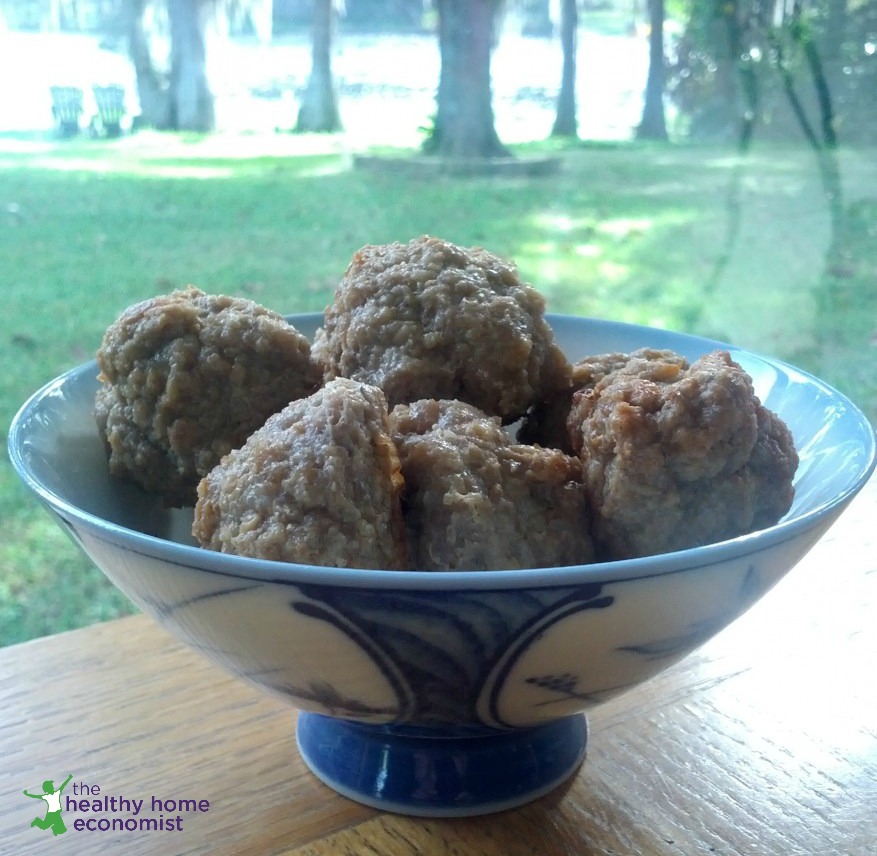 My kids are in love with the pork meatballs I make with quality pastured meat I obtain from a local farm. This tasty, nutrient dense meat comes from happy pigs that are free to run around outside in the sunshine. Pastured pigs that are exposed to UVB rays produce lots of vitamin D which is stored in the lard.
My kids are in love with the pork meatballs I make with quality pastured meat I obtain from a local farm. This tasty, nutrient dense meat comes from happy pigs that are free to run around outside in the sunshine. Pastured pigs that are exposed to UVB rays produce lots of vitamin D which is stored in the lard.
These happy hogs compare with the unfortunate and miserable animals from huge hog confinement operations known as CAFOs (Concentrated Animal Feeding Operations). Believe it or not, a single CAFO building housing confined pigs might hold 1,000 or more sows or 10,000 or more market hogs! These poor animals don’t even have enough room to turn around in most cases!
Do you want your pork to come from these animals? I sure don’t!
There’s no way I want one red cent of my food dollars to go to the companies that treat animals this way not to mention that this type of industrialized farm is detrimental to the environment and the food produced from it will not compare with the nutrition from hogs living outside in the fresh air and sunlight.
Marinated Pastured Pork Meatballs
When you make the effort to obtain truly pastured meat from happy hogs to make pork meatballs, you will be delighted to discover very little seasoning is required as the taste is fabulous and rich all on its own.
These pastured pork meatballs can be served alone with veggies cooked in butter (my usual way) or can be used for that occasional bowl of spaghetti and meatballs if you desire. Another idea is to slice them in half, add a homemade pizza sauce, melt some cheese on top and serve on sourdough buns.
Leftover pork meatballs are great to pack in lunchboxes the next day too. My problem is that most of the pork meatballs are gone so fast I don’t have hardly any leftovers. I had to practically arm wrestle my teenager to snap the picture above before all the meatballs were gone from the baking pan!
Enjoy this ground pork recipe? Try this recipe for breakfast sausage too.

Marinated Pork Meatballs Recipe
This recipe for pastured pork meatballs is marinated for optimum digestibility as practiced by traditional cultures.
Ingredients
- 1 lb pastured ground pork
- 1 egg
- 2 crusts sourdough or sprouted bread
- 1/4 cup soy sauce preferably unpasteurized and traditionally brewed
- 1/2 tsp sea salt
- 1/4 tsp pepper
Marinade
- 1/2 cup lemon juice
- 1/2 cup liquid whey strained either from clabbered milk, yogurt or kefir
Instructions
-
Marinate ground pork in lemon juice/liquid whey mixture in a glass bowl uncovered in the refrigerator for 1 hour. Dry the meat thoroughly with paper towels or a clean dishcloth.
-
Place dried out bread crusts in a food processor and pulse until you have evenly sized breadcrumbs.
-
Place marinated ground pork in a bowl and mix in bread crumbs and egg with your hands. Add sea salt, pepper and soy sauce and mix again.
-
Form meatballs with your hands slightly smaller than the size of a ping pong ball. Place meatballs on a stainless steel baking pan or a glass baking dish and bake on 350 F/177 C until browned and thoroughly cooked (about 40 minutes).
-
Serve immediately.
-
Refrigerate leftovers and reheat as desired.
Sarah, The Healthy Home Economist








I’m rather new to working with ground pork. I understand the reasoning behind soaking the pork in apple cider vinegar, but do I need to use 1 cup of apple cider vinegar? I experimented with this once and let the ground pork marinate overnight–which was several hours later. By that time the ground pork’s texture had really softened, and the aroma was a real turn-off for me and my husband. I’ll admit I did not think to use paper towels to absorb the vinegar when I started cooking it. The result was awful–the pork was overwhelmed by the vinegar. Is there a guideline for minimum soaking time and amount of vinegar used per pound? I’m not sure I would like the taste of apple cider vinegar every time I try to use ground pork.
You don’t have to use vinegar. Lemon juice is fine too as is a half and half blend of lemon juice and liquid whey (gives VERY tender results for chops). https://www.thehealthyhomeeconomist.com/pork-healthy-or-unhealthy/
Small amounts of unpasteurized soy sauce aren’t really a problem, but cooking with it is reckless. It should only be used as a condiment after cooking has taken place. Otherwise it is like cooking a kombucha or cooking lacto fermented vegetables with the added benefit of toxic soy. Dead, lifeless, and void of all useable nutrients associated with raw fermented foods.
Why would you advice cooking unpasteurized soy sauce? You are killing everything good about it and it not only completely defeats the purpose but leaves you ingesting cooked, toxic soy.
I grew up on a farm and we raised pigs. I still eat pork on a regular basis, but only pastured. Taste wonderful. No health problems and we love pork!
Also good as meatloaf
Do we need to soak our pork before cooking this? and how much vinegar and for how long?
Q. Why is pork not included in Nourishing Traditions?
A. It was left out in deference to co-author Mary Enig, who is Jewish. But she agreed to include some pork recipes in Eat Fat Lose Fat. I think pork needs to be carefully prepared by soaking in something acidic–usually vinegar–this is how it is done in China–or curing in some way, tantamount to fermentation.
Darla, we make ours with Braggs Liquid Aminos, too…so delicious! 😀
I made these tonight and they were delicious! I used Braggs liquid aminos. Is that a traditionally brewed soy sauce or is it no different than regular? Thanks for the recipe!
Great recipe! Thanks.
Wondering where you get pastured pork? I saw you are in Central FL and so are we. Could you tell where the farm is?